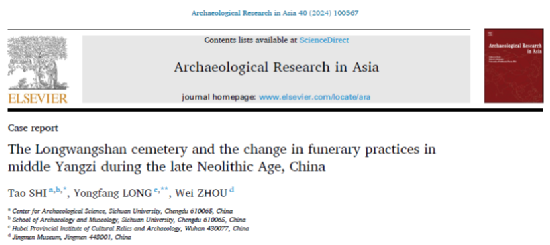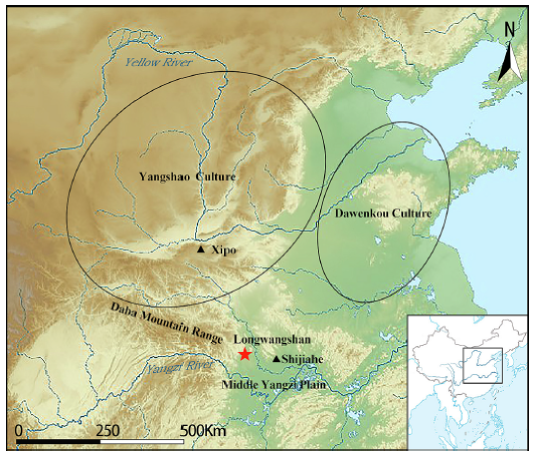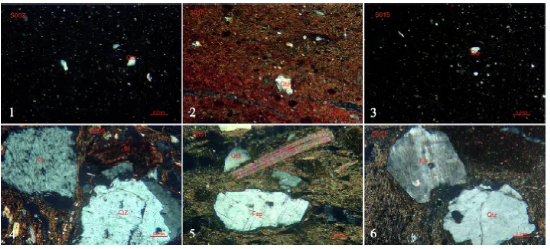The archaeological team from the Center for Archaeological Science, Sichuan University published a research article in the international journal Archaeological Research in Asia.
Recently, the Center for Archaeological Science, Sichuan University team published a latest research article titled "The Longwangshan cemetery and the change in funerary practices in middle Yangzi during the late Neolithic Age, China" in the internationally renowned archaeological journal Archaeological Research in Asia. Based on the analysis of archaeological materials from the Longwangshan cemetery, the article discusses the transition process and significance of funerary practices from the Youziling Culture to the Qujialing Culture in the middle reaches of the Yangtze River during the late Neolithic Age. SHI Tao, Associate Professor of Center for Archaeological Science, Sichuan University, is the first author and co-corresponding author of this article, LONG Yongfang of Hubei Provincial Institute of Cultural Relics and Archeology is the co-corresponding author, and ZHOU Wei of Jingmen Museum is the co-author.

At the beginning of the article, the authors pointed out that processual archaeology often directly corresponds funerary practices to the social organization of the deceased during their lifetime in the study of tombs. However, with the discussion of funerary practices in post-processual archaeology, the current research on tombs is more inclined to explore the social relations of the living reflected in funerary rituals and practices. In the specific analysis of tombs, the space inside the coffin is often considered to be more closely related to the deceased, while the outside of the coffin is considered to be the remains of performative ritual activities held by the living. The middle reaches of the Yangtze River entered a stage of rapid development and complexity starting from the Youziling Culture period. However, there are not many published materials on important cemeteries during this period. The Longwangshan cemetery is an important source of information reflecting funerary practices during this period. Through the analysis of the materials unearthed from this cemetery, the authors attempt to explore the changes and significance of funerary practices in the process of social complexification in the middle reaches of the Yangtze River.

Geographical location of the site
The authors divided the Longwangshan cemetery into three phases: the first phase corresponds to the late Youziling Culture, the second phase corresponds to the transition stage from the Youziling Culture to the Qujialing Culture, and the third phase corresponds to the Qujialing Culture period. The burial materials of these three phases basically reflect a continuous tradition of funerary practices. The pottery in the tombs can be basically divided into two categories. The first category is extremely large in quantity, mainly including tripods, small jars/pots, curved-belly cups, dou (stemmed dishes), long-necked pots, etc. Most of them are made of fine clay black pottery and are small in shape. The manufacturing technology is similar. They should not be daily utensils, but specially made mingqi (burial objects). These objects are basically distributed in the middle of the tombs and should be inside the coffin, which are symbolic utensils specially for the deceased to use underground. The second category of objects mainly includes large vats, jars, basins, etc., mainly vats. The shapes are all large, mostly red pottery or gray pottery. The pottery quality and color of each object are basically different, and the manufacturing technology is also different. They should not be specially made, but brought into the funeral site by different mourners during the funeral ceremony. Most of these objects are placed outside the coffin and should be the remains of public rituals during the funeral. This kind of vat is widely present in the late Neolithic Age in China and is likely to be a tool for banqueting activities in funerals.

Results of petrographic analysis of pottery
From the Youziling Culture to the Qujialing Culture, two changes are worth noting: First, more and more tombs began to have the second category of relics buried outside the coffin; second, some larger tombs had more of the second category of relics buried with them, although the first category of objects has always been positively correlated with the size of the tomb. This also shows that, although offering sacrifices to the dead has always been a means of displaying social status or prestige from the Youziling Culture to the Qujialing Culture, public banquets are increasingly becoming a way to compete for social status or prestige. This also reflects that, with the increasing degree of social complexification in the middle reaches of the Yangtze River, the local people may have continuously demonstrated and strengthened their social status and prestige by holding and expanding the scale of public ritual activities.
